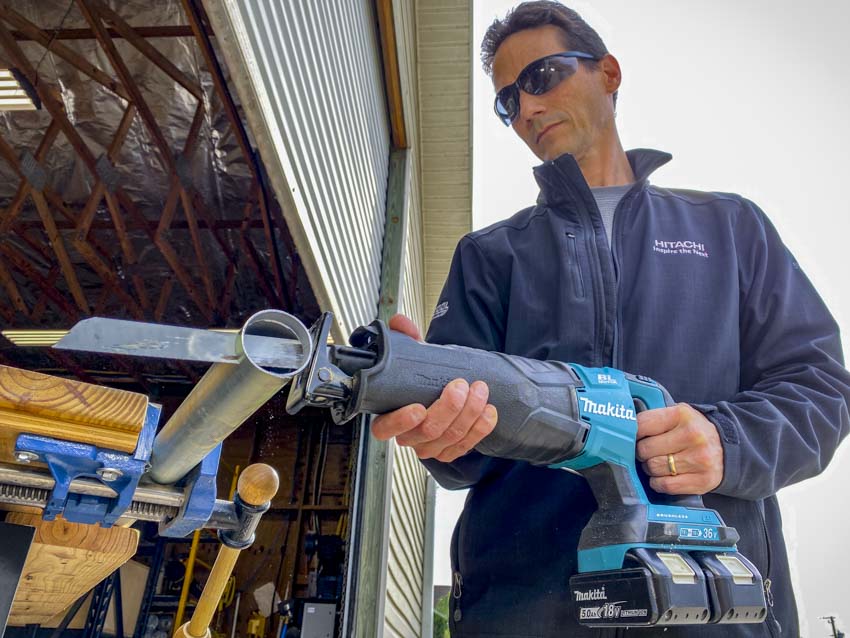Yes, a reciprocating saw can cut metal. The blade on a reciprocating saw is thin and designed to cut through metal without getting stuck. If you are cutting through thick metal, you may need to use a different blade or make multiple cuts.
A reciprocating saw is a versatile tool that can be used for a variety of tasks, including cutting metal. While a reciprocating saw can cut through most metals, there are some types that are more difficult to cut than others. In general, softer metals like aluminum and copper are easier to cut with a reciprocating saw than harder metals like stainless steel or cast iron.
If you’re not sure whether your reciprocating saw will be able to handle the job, it’s always best to consult the owner’s manual or ask an expert before proceeding.

Credit: www.protoolreviews.com
How Thick of Metal Will a Reciprocating Saw Cut?
A reciprocating saw is a power tool that can cut through metal. The thickness of the metal that it can cut through depends on the blade that is being used. There are blades available that can cut through metal up to 6 inches thick.
How Do You Use a Reciprocating Saw on Metal?
If you’re working with metal, you’ll want to use a reciprocating saw equipped with a metal cutting blade. These blades have teeth that are designed to cut through metal quickly and easily.
When using a reciprocating saw on metal, it’s important to make sure that the material is securely clamped down.
This will help to prevent the material from moving around while you’re cutting, and will also help to ensure that your cuts are straight.
Once the material is clamped down, you can begin cutting by slowly moving the blade back and forth. Apply moderate pressure as you cut, and try not to force the blade through the material – let the teeth do the work.
If your saw has a variable speed setting, start at a lower speed and increase as needed.
As always when using power tools, be sure to wear safety glasses and ear protection while operating the reciprocating saw.
Will a Reciprocating Saw Cut Rebar?
It’s a common question- can a reciprocating saw cut rebar? The answer is yes, but there are a few things you should know before trying it. First, while any good quality recip saw will be able to handle cutting through rebar, it’s going to put quite a strain on the tool.
That means that if you’re going to be doing a lot of cutting, or if the rebar is especially thick, you might want to consider using a different tool designed specifically for the job like an abrasive cutoff wheel or hydraulic shears. Second, even though it can be done, cutting through rebar is generally not considered safe. The reason being that when the blade hits the steel it can cause sparks which could easily ignite something nearby (especially if there’s oil or other flammable liquids present).
So, if you do decide to use your reciprocating saw to cut rebar make sure you’re doing it in a well ventilated area and take all necessary precautions.
Can a Reciprocating Saw Cut Metal Bolts?
A reciprocating saw can cut metal bolts, but it is not the ideal tool for the job. A recip saw is designed for cutting through wood and other materials, not metal. If you must cut a metal bolt with a recip saw, use a blade that is specifically designed for cutting metal.
These blades have teeth that are much harder than the teeth on a standard wood-cutting blade, so they will stay sharp longer and be able to handle the tougher material.
Cutting Steel Chapter 2 – The Reciprocating Saw
How Thick Metal Can a Reciprocating Saw Cut
A reciprocating saw is a handheld power tool that can be used for a variety of tasks, including cutting through metal. The thickness of the metal that a reciprocating saw can cut through depends on the blade that is being used. Some blades are designed for cutting through thick metal, while others are better suited for thinner materials.
In general, however, a reciprocating saw can cut through metal up to about 3/8 inch thick.
Conclusion
A reciprocating saw can cut metal if the right blade is used. Bi-metal blades are the best type to use because they are specifically designed for cutting through both soft and hard materials. The teeth on these blades are much harder than those on a standard wood-cutting blade, so they will stay sharp longer and be able to cut through tougher materials.
Table of Contents

